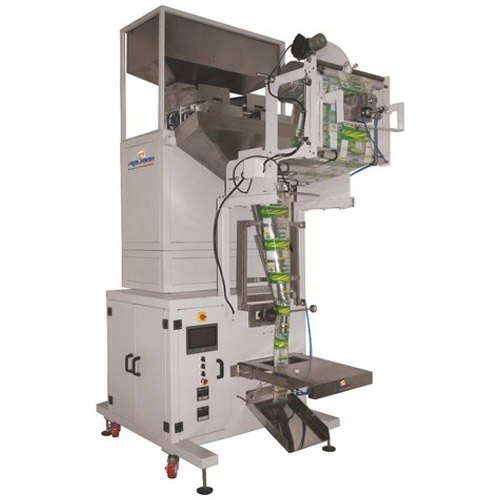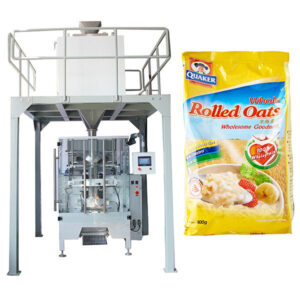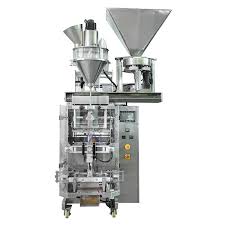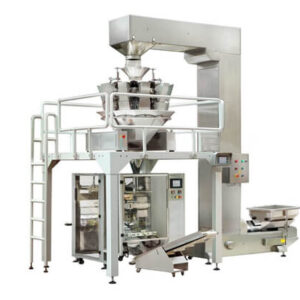Description
| Specification | Details |
|---|---|
| Machine Type | Automatic Grain Packing Machine |
| Capacity | Adjustable, typically up to X kg/hr |
| Packaging Material | Polyethylene (PE) bags, laminated pouches, etc. |
| Filling Type | Auger filling, weigh filling, volumetric filling, etc. |
| Bag Sizes Supported | Customizable, typically ranging from X to Y grams/kilograms |
| Bag Dimensions | Adjustable, typically ranging from LxW to LxWxH (in mm) |
| Control System | PLC (Programmable Logic Controller) with touchscreen interface |
| Power Supply | Standard AC power, typically 220-240V, 50-60Hz |
| Power Consumption | Depends on machine size and configuration, typically between X to Y kW |
| Air Requirement | Compressed air required for certain operations, typically X bar |
| Operating Speed | Adjustable, typically between X to Y bags per minute |
| Accuracy | Typically within +/- Z% of target weight |
| Material Construction | Stainless steel for contact parts, powder-coated mild steel for frame |
| Safety Features | Emergency stop button, overload protection, safety interlocks |
| Optional Features | Date coding, batch printing, nitrogen flushing, vacuum sealing |
| Dimensions (LxWxH) | Depends on machine size and configuration |
| Weight | Depends on machine size and configuration |
| Manufacturer | [Manufacturer Name] |
| Country of Origin | [Country] |
| Warranty | [Warranty details] |
Courses about Grain Packing Machines
Machines of grain packing are automatic devices that pack grains orderly into a variety of sorts of packaging such as bags, pouches, or containers. These machines are used widely in food processing industries, agricultural sectors, and packaging plants to streamline the process of packaging and reduce human errors while packing.
kinds of Grain Packing Machines
Vertical Form Fill Seal (VFFS) Machines
These are versatile machines and are commonly used for packing grains. They make bags out of film rolls and fill them with grains after sealing them vertically. Such machines can be applied when packing different sizes and volumes of grains.
Horizontal Form Fill Seal (HFFS) Machines
HFFS machines pack grains horizontally making them perfect for the task at hand. Their films are made into pouches before they get packed with these commodities for selling purposes. When it comes to non-stop filling in large quantities and very high speeds HFFS is ideal.
Open Mouth Bagging Machines
Open-mouth bagging machines put grains into already-made bags that have an open-mouthed side. The machine fills the bags quickly with grains before sealing them through sewing or heat sealing.
Valve Bagging Machines
Valve bagging machines have been designed specifically for packing grain inside valve bags, which have a self-closing valve making its handling as well as filling easier. These machines usually work on large quantities of grain quite speedily since they are used in bulk grain packaging in most cases.
How Grain Packing Machines Work
There is variation in the operation mechanisms depending on the type of grain packing machine but there are some general steps:
Bag or Pouch Formation: The machine forms bags or pouches from a roll of packaging material.
Filling: Grains are accurately measured and dispensed into the bags or pouches.
Sealing: The bags or pouches are sealed to prevent spillage and maintain product freshness.
Optional Additional Steps: Some machines may include additional steps such as printing expiry dates or applying labels.
Characteristics of Grain Packing Machines
The following are some of the features that enhance efficiency, accuracy, and versatility in grain packing machines:
Automatic Operation: In most cases, they are automatic hence minimal manual intervention is needed.
Adjustable Parameters: Different parameters can be adjusted by the operator including bag size, filling volume, and sealing temperature to be able to cater to various grains and packaging requirements.
High-Speed Performance: These machines can pack grains at high speeds, increasing productivity and throughput.
Integrated Weighing Systems: Many machines are equipped with integrated weighing systems to ensure accurate measurement and filling.
Multi-Functional: Some advanced grain packing machines can handle multiple packaging formats and sizes, offering versatility in packing operations.
Functions and Benefits of Grain Packing Machines
Grain Packing Machines perform several important functions which are crucial for an efficient and reliable packaging process:
Weighing: This is aimed at ensuring uniformity in each package by weighing the grains accurately before placing them into a bag/container/pouch.
Filling: The right amount of grains should be dispensed into each bag or pouch during this process.
Sealing: The bags or pouches must be sealed properly so that there will be no leakage thus keeping the product fresh all along its shelf life on store shelves
Printing and Labeling: It may also have options such as printing expiry dates or lot numbers onto its packages while labeling can help trace products back to their source if desired by customers who want more information than just what’s written on an item
Quality Control: Check if everything is packed in according to specifications – abnormal packaging conditions could indicate errors made within these processes resulting from defects found during quality assurance procedures while monitoring parameter settings throughout production stages guarantee performance without problems in any way
Improved Precision: Packaging consistency and reducing product over-dosage are achieved through careful weighing and filling.
Enhanced Quality of Product: Grains are protected from moisture, contamination, and spoilage by sealed packaging which helps in preserving the product’s freshness and quality.
Cost Savings: Reduced labor costs as well as higher productivity result in overall savings in the cost of packing operations.
Versatility: Grain packer machines can handle different sizes and types of packaging materials to meet various customer demands.
Compliance: Adherence to industry standards and regulatory requirements for accurate weighing, labeling, and packaging ensures compliance with law.
Future Trends in Grain Packing Machines
As technology continues to advance, several trends are shaping the future of grain-packing machines:
IoT Integration: Internet of Things (IoT)-based machines can collect data in real-time enabling predictive maintenance, performance optimization, and remote monitoring among other things.
Advanced Robotics: In the next years robotics will dominate grain packing; this will increase the speed at which packaging can be done improve precision hence flexibility.
Smart Packaging Solutions: The use of smart packaging technology such as active packaging or intelligent sensors is expected to rise hence protecting products making them last longer and even improving traceability within supply chains.
Sustainable Packaging: As people become more concerned about environmental sustainability there is a growing demand for eco-friendly forms of packaging. Future grain packing machines may incorporate sustainable materials and energy-efficient technologies to reduce environmental impact.
AI and Machine Learning Algorithms: This technique uses artificial intelligence along with machine learning algorithms that could optimize the packing process; improve its accuracy as well as adapt it to changing production needs dynamically.
Customization & Personalization: This trend will see flexible modular design facilitate consumer preferences for custom-designed packages that vary widely from one another.
Frequently Asked Questions (FAQs)
What type/s of grains can be packed using grain packing machines?
Rice, wheat barley oats corn, and pulses are some of the grains that can be packed by grain packing machines.
Can grain packing machines handle different packaging materials?
Yes. Grain packers can accommodate a variety of packaging materials including plastic films, woven polypropylene bags, and paper.
Are there any safety considerations when operating grain-packing machines?
There are safety guidelines provided by manufacturers to maintain the safe conduct and operation of this equipment.
How can I ensure the accuracy of grain-packing machines?
Precision may be achieved through regular calibration and maintenance practices. Integrated weighing systems as well as quality control mechanisms also help in maintaining high precision levels.
What is the typical lifespan of a grain-packing machine?
The life span for a grain packer will depend on its usage, maintenance practices as well as quality. It could take many years if properly taken care of.
Can grain packing machines handle fragile grains without damage?
Consequently, these modern-day machines provide for gentle handling of delicate grains thus minimizing breakages and guaranteeing product integrity.
Do grain packing machines require specialized maintenance?
While routine maintenance is necessary, many manufacturers provide guidelines and support for maintaining such devices effectively.
Are grain packing machines easy to operate?
Yes. Most advanced ones come with user-friendly interfaces as well as intuitive controls making them easy to operate even without much training required to learn their functions.
Can grain packing machines be customized for specific packaging requirements?
Yes. Many manufacturers allow customers to customize their machinery according to specific packaging formats or sizes and production volumes they have in mind.
Can grain packing machines handle different types of grains?
Indeed, various types of grains such as rice, wheat, barley oats corn pulses, and others can be accommodated in these kinds of packers which are designed for multi-usage purposes depending on the availability or resourcefulness at hand thereby stirring demand across diverse market segments globally.





